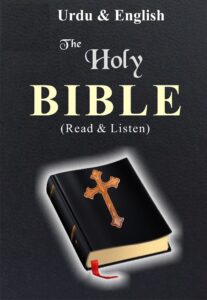Bible in Urdu translation: The Bible in Urdu refers to the translation of the Christian Bible into the Urdu language, which is widely spoken in Pakistan and parts of India. The translation was a significant effort to make the Christian scriptures accessible to Urdu-speaking people. Here’s an overview of the Urdu Bible translation:
was a significant effort to make the Christian scriptures accessible to Urdu-speaking people. Here’s an overview of the Urdu Bible translation:
1. History of Bible Translation into Urdu
The translation of the Bible into Urdu has a long history, with the main goal of providing the sacred text to the Urdu-speaking Christian community in the Indian subcontinent. The key developments are as follows:
William Carey’s Contribution
-
William Carey, a British missionary and linguist, is often credited as one of the pioneers in translating Christian texts into regional languages in India. He is known for his early work on translating the New Testament into Urdu in the early 19th century.
-
His translation work laid the foundation for later, more complete versions of the Bible in Urdu. However, his work on the Urdu Bible was initially based on translations in other languages, such as Persian and English, before a complete translation from Hebrew, Greek, and Aramaic was undertaken.
British and Foreign Bible Society (BFBS)
-
In the 19th century, the British and Foreign Bible Society played a significant role in producing a full Urdu translation of the Bible. Their translation was one of the first widely accepted versions of the Bible in Urdu.
-
The BFBS worked in collaboration with scholars who were fluent in both the biblical languages and Urdu to ensure an accurate and faithful translation.
The Role of Other Scholars and Missionaries
-
Over time, other missionaries and linguists working within the Christian missionary community continued to refine the translation. Many of these scholars worked to make the text more readable and understandable to the general Urdu-speaking public, including using contemporary forms of the Urdu language.
-
Additionally, the Urdu Bible Society and other local Christian organizations took on the task of publishing and distributing the Bible to the wider population, including those with limited access to the original Hebrew and Greek texts.
2. Modern Translations of the Urdu Bible
There are several different versions of the Urdu Bible available today, ranging from more formal, traditional translations to those using modern, conversational Urdu. The most well-known versions include:
1. The Urdu Bible (1823)
-
The first complete translation of the Bible into Urdu was produced in 1823 by the British and Foreign Bible Society. This version was based on earlier efforts by William Carey and other early translators.
-
It was highly influential for Urdu-speaking Christians in the Indian subcontinent and remained the standard for many years.
2. The Urdu Bible (1957)
-
A major revision of the original translation was completed in 1957. This version sought to update the language and make it more accessible to contemporary readers.
-
This version is still widely used by many Urdu-speaking Christians today, especially in Pakistan and India.
3. The New Urdu Translation (2000s)
-
In the 21st century, a more modern translation of the Bible in Urdu was created to make the text more relatable to younger generations and speakers of everyday Urdu.
-
This translation aimed to keep the meaning faithful to the original text while using simplified and conversational Urdu, which made it easier for a wider audience to understand.
3. Accessibility and Formats
The Bible in Urdu is available in several formats to suit modern readers:
-
Printed versions: The most common way the Urdu Bible is still accessed, especially in church services and personal study.
-
Digital formats: Today, the Urdu Bible is available online and through apps, making it accessible to people across the world with internet access.
-
Websites such as BibleGateway and YouVersion offer Urdu translations of the Bible.
-
Various Bible apps in Urdu also allow users to read, listen to, and study the Bible on their smartphones or computers.
-
Audio Bible in Urdu:
-
For those who prefer to listen rather than read, audio Bibles in Urdu are available, helping make the text accessible to people who may have difficulty reading.
-
These are especially popular among the illiterate population or those with visual impairments.
4. The Significance of the Urdu Bible
-
The translation of the Bible into Urdu was a monumental effort that allowed Urdu-speaking Christians, especially in Pakistan and India, to engage with the scriptures in their native language.
-
It also played an important role in the spread of Christianity in the Indian subcontinent, as many people who had no knowledge of languages like Greek or Hebrew were able to read the Bible in their own tongue.
5. Current Usage and Influence
-
The Urdu Bible continues to have a significant impact on the lives of Urdu-speaking Christians in the region. It is used in worship services, personal study, and as a source of spiritual guidance.
-
It is also a key tool for evangelism, as it allows Christians to share their faith with Urdu-speaking communities in a culturally relevant way.
Conclusion
Bible in Urdu translation: The Urdu Bible is a critical and invaluable resource for Urdu-speaking Christians, and its translation history reflects the long-standing efforts of missionaries, scholars, and linguistic experts. Today, with various translations and modern formats like apps and audio Bibles, it remains an essential tool for both personal faith and communal worship among the Urdu-speaking Christian community.
 |
 |

Comments are closed.